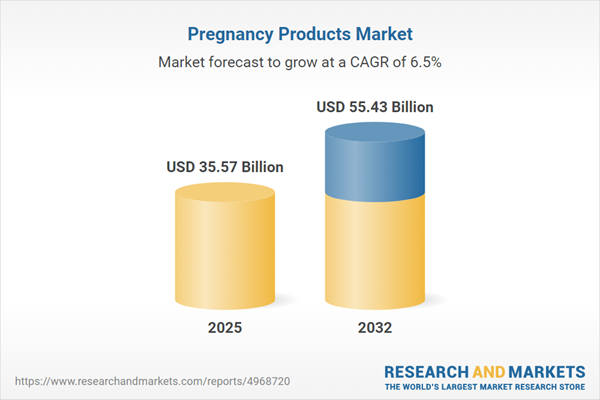Speak directly to the analyst to clarify any post sales queries you may have.
Senior leaders in the pregnancy products market must navigate a complex ecosystem defined by technological innovation, regulatory evolution, and continually shifting consumer expectations. Success depends on strategic agility and market knowledge to capitalize on opportunities and maintain a robust position.
Market Snapshot: Pregnancy Products Market—Current Evolution and Growth
The pregnancy products market demonstrates stable year-over-year expansion, with momentum fueled by the growing global preference for holistic maternal health solutions. As prenatal and postnatal care increasingly become focal points for consumers, organizations are innovating to deliver comprehensive wellness. The sector’s dynamic character is shaped by swift product advancements, responsive supply chain strategies, and evolving regulatory pathways. Businesses face the dual priorities of complying with diverse regulations and meeting expanding regional market needs, requiring proactive adjustments in both operational models and product offerings. Competitive advantage now centers on delivering reliable, agile solutions that anticipate consumer wellness trends and adhere to regulatory demands.
Scope & Segmentation of the Pregnancy Products Market
- Product Types: Herbal teas, maternity support belts, prenatal vitamins, nutritional supplements, and specialized skincare products form the core offerings. Each category is developed to address physical comfort and nutrition during every stage of pregnancy and recovery.
- Distribution Channels: E-commerce and digital health platforms increase market reach and improve product selection, while pharmacies and specialty stores deliver accessibility for consumers preferring in-person experiences. Traditional and digital channels together cater to a spectrum of maternal preferences.
- Application Timing: Solutions are tailored to specific trimesters and postnatal periods, supporting a stage-based approach that meets evolving maternal health needs.
- Regions: Markets across the Americas, Europe, Asia-Pacific, and Middle East & Africa vary in regulatory requirements and consumer expectations, demanding localized strategic execution and operational flexibility to ensure success.
- Industry Players: Key companies such as Johnson & Johnson, Procter & Gamble, Bayer, Pfizer, Reckitt Benckiser, Church & Dwight, Abbott, Nestlé, DSM, and GlaxoSmithKline manage extensive portfolios. Cross-sector collaboration is common as organizations pursue product innovation, stronger compliance, and expansion in established and emerging regions.
Key Takeaways: Strategic Insights for Senior Decision-Makers
- Implement digital recommendation tools to personalize the customer journey and create value for both consumers and channel partners, supporting future scalability.
- Advance supply chain transparency and sustainability in packaging to respond to stringent regulatory expectations and environmental responsibility initiatives worldwide.
- Adopt omnichannel and subscription-based distribution models, ensuring product accessibility while adapting to region-specific and consumer channel preferences.
- Utilize in-depth market and compliance intelligence to build resilient go-to-market strategies that address new regulatory complexities and dynamic demand environments.
- Foster partnerships with healthcare professionals using telehealth solutions and digital endorsement, reinforcing brand trust and expanding reach in digitally oriented markets.
- Prioritize investment in innovative product design and packaging improvements, strengthening market distinctiveness and deepening consumer loyalty globally.
Tariff Impact: Managing Global Supply Chain Complexity
Recent shifts in international tariffs on raw material imports are driving changes throughout the pregnancy products supply chain. Organizations are fine-tuning procurement and logistics to optimize costs and ensure steady delivery. Aligning with emerging compliance standards reduces risk and counteracts volatility from trade disruptions. These adaptive strategies underpin operational efficiency and business continuity in a fluctuating global environment.
Methodology & Data Sources
This assessment integrates research from industry journals, regulatory bulletins, and official company reports. Strategic perspectives are further supported by expert input in maternal health, compliance, and supply chain optimization to ensure relevance for executive decision-making.
Why This Report Matters: Insights for Senior Executives
- Provides actionable recommendations for managing regulatory shifts and increasing consumer demand for inclusive maternal wellness products.
- Delivers practical guidance for executing digital transformation, adapting supply chains, and ensuring global compliance to support long-term business growth.
- Supports structured planning that accounts for regulatory, sustainability, and technological changes in forming comprehensive market strategies.
Conclusion
This report delivers focused guidance for refining growth strategy, elevating compliance processes, and unlocking added value as the pregnancy products market develops.
Additional Product Information:
- Purchase of this report includes 1 year online access with quarterly updates.
- This report can be updated on request. Please contact our Customer Experience team using the Ask a Question widget on our website.
Table of Contents
3. Executive Summary
4. Market Overview
7. Cumulative Impact of Artificial Intelligence 2025
Companies Mentioned
The companies profiled in this Pregnancy Products market report include:- Johnson & Johnson
- The Procter & Gamble Company
- Bayer Aktiengesellschaft
- Pfizer Inc.
- Reckitt Benckiser Group plc
- Church & Dwight Co., Inc.
- Abbott Laboratories
- Nestlé S.A.
- Koninklijke DSM N.V.
- GlaxoSmithKline plc
Table Information
| Report Attribute | Details |
|---|---|
| No. of Pages | 184 |
| Published | October 2025 |
| Forecast Period | 2025 - 2032 |
| Estimated Market Value ( USD | $ 35.57 Billion |
| Forecasted Market Value ( USD | $ 55.43 Billion |
| Compound Annual Growth Rate | 6.5% |
| Regions Covered | Global |
| No. of Companies Mentioned | 11 |









